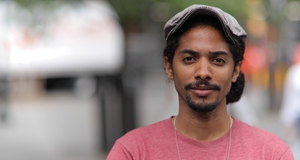Featured Article:The American Immigrant: A Roach In The Glue - Examining the work of Hemon and Kambanda
By
2010, Vol. 2 No. 02 | pg. 1/1
KEYWORDS:
At the conclusion of her essay, “My New World Journey,” Nola Kambanda writes that “Sometimes I am not sure whether home is behind me or in front of me…I might just be attaching [this longing] to those things that are familiar to me…it might not be a place at all…home might be family…It might be the people who make me feel” (155). However, at the conclusion of his short story, “Blind Jozef Pronek,” Aleksandar Hemon writes of his protagonist’s perception of home, and hardly any of his description fits finely into Kambanda’s, albeit rather vague, definition. To accept Kambanda’s conclusion is to ignore the nuanced but powerful indictment of America as a home that appears in both her piece and Hemon’s. Hemon paints an America that often seems to be lacking in love, family, and feelings as a whole—just simply a plethora of substances abused by ungrateful natives and guilt-ridden arrivals. When we first meet Jozef Pronek, the Sarajevo blues brother and “freedom-loving writer” who receives an official invite from the U.S., there are news reports of war and tension in Bosnia (167). Sarajevo is his “home,” his place of origin, where he is part of a family and social unit, and where he resides in his commercial property. His new place of residence and work becomes Chicago, to which he settles specifically for the same reason men of all ethnic backgrounds travel across the globe: a woman. He stays with her and her boyfriend and tries to live the American dream—or really, simply live. The toll of Pronek’s immigrant experience seems to be a great deal of guilt, dissatisfaction, and anxiety. The excesses of America become more of a curse than a blessing: Pronek gains weight from all the junk food, feels panicked for not knowing the names of the surrounding plants, masturbates in a detached manner, and tries to wash off his sins in showers only to feel guilty when he recalls the water shortages in the old country. If home is the location of our family or those who make us feel, America is no home to an immigrant like Jozef Pronek.Hemon’s most illuminating discussion of home comes at the end of the story, in Pronek’s cheerless vision of home in America. In his envisioned routine, Pronek would get a rather loveless telephone message from a woman, watch a sports game before he would visit his parents in Michigan (“who he knew would just annoy the hell out of him”) and “slowly drink until he passed out” (181). Hemon’s American home is a beacon of substances and opportunity (a telephone, entertainment, family, food, and drink) only to be wasted. Instead of celebrating his parents’s mere being alive, he thinks about how they annoy him. Instead of finding true love, the woman who calls already has a boyfriend and might be using Pronek for sex. Instead of feeling grateful for his new home, he numbs the experience with a liquid depressant. In fact, Hemon’s America hardly seems like home for its natural-born inhabitants. The people Pronek stays with for his adventure are Andrea and Carwin, two lovers who appear neither to be in love nor make love. Hemon’s Andrea is a mildly depressed artist (her painting entitled “Home” is simply a portrait of her with her arms around two pigs) and portrays her boyfriend as a beer-drinking, sports-watching, foul-mouthed, porn-viewing, well, pig. The two do not share a bedroom, and they are constantly fighting and swearing, even though their home has the benefits any Sarajevo citizen on CNN would have died for. Their apartment consists of McDonalds, beer, and cigarette paraphernalia—a messy waste of products and goods. Another commodity taken for granted in Hemon’s America is family, one of Kambanda’s key words in her definition of home. While families come to their bloody ends overseas, Carwin says, “Man, I hope I never see my fuckin’ parents again” (172). Pronek, meanwhile, fears greatly for his parents’s lives, as he watches the bloody scenes of war on the cable news—where any severed body part could belong to a friend or relative—experiencing the unsettling epiphany that “death was the cessation of life” and that whatever those familiar faces from his old home were doing “would never continue. Even their suffering would end” (179). At least in America, as weak as the life there may be, there was at least the offer of life at all. Still, Hemon challenges this by utilizing death language throughout the narrative in describing the working immigrant’s experience. Pronek begins his business journey with kitchen work for five dollars an hour before receiving the high honor of heading garbage disposal, for which Pronek drags loaded garbage cans “like corpses” to the kitchen (177). He eventually gets laid off in an “absurd” incident involving Pronek not knowing the difference between iceberg and romaine lettuce (179). Thankfully, he ends up getting a six dollar-an-hour job as a bathroom cleaner (or “shit boy”) for which he “mercilessly effac[es] all trace of human life” (180). These death-related phrases (corpses, effacing human life) reveal the author’s tone and attitude towards working towards the American dream: it sounds rather nightmarish. The idea of death finally brings us back to the end of Hemon’s story and Pronek’s American daydream (which can be interpreted as Pronek’s companion piece to Andrea’s sad self-portrait). The routine of home for Pronek simply meant a continuation and sustaining of life. He would enter his apartment and see “where yesterday’s dried-up roach hung from the ceiling and today’s was still alive, stuck in the sweet glue” (181). This is the most apt metaphor for Hemon’s take on the American experience: a dog-eat-dog business world of capitalist competition (where one roach is left up to dry) while an immigrant like Hemon is stuck (he remains in America because home would simply mean death) in the sweet glue of the states. Pronek would say “Honey, I’m home,” a throwback to the American sitcom, perhaps specifically a reference to Fred Flintstone’s nightly greeting to Wilma after a long day’s blue-collar work. Of course the sad irony in Hemon’s writing is that Pronek is not really saying it to anyone; he is technically at “home” in America, but undoubtedly alone.
Hemon, Aleksandar. "Blind Jozef Pronek". The New Yorker April 19, 1999: 86. (Print.) Kambanda, Nola. “My New World Journey.” Crossing Into America. (2003): 147-155. (Print.) Suggested Reading from Inquiries Journal
Inquiries Journal provides undergraduate and graduate students around the world a platform for the wide dissemination of academic work over a range of core disciplines. Representing the work of students from hundreds of institutions around the globe, Inquiries Journal's large database of academic articles is completely free. Learn more | Blog | Submit Latest in Literature |














